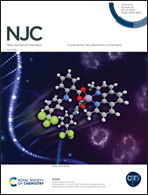A novel acylhydrazone-based self-assembled supramolecular gel for ultrasensitive alternating fluorescence detection of Fe3+ and H2PO4−†
Abstract
A novel gelator (named DN) was designed and synthesized with an acyl hydrazone group as the self-assembly site. It can be self-assembled into stable organogels (named ODN) in N,N-dimethylformamide (DMF) with a critical gel temperature and concentration (60 °C and 10 mg mL−1). Interestingly, under 365 nm UV light, the ODN exhibits bright blue Aggregation Induced Emission (AIE), which could respond to multiple external stimuli. The supramolecular organogel ODN shows a fluorescent “OFF” response to the metal ion Fe3+ and the state of the gel ODN remains constant before and after detection. Notably, metal gels (Fe-ODN) formed by ligating ODN gel with Fe3+ can detect H2PO4− with increased fluorescence intensity emission. When Fe3+ and H2PO4− are added alternately to the ODN, the fluorescence response cycle “ON–OFF–ON” can be performed at least four times. The binding mechanism of the supramolecular organogels (ODN) to ions has been investigated through a series of characterization experiments. Meanwhile, the organogel sensor ODN can also be used as an ion-responsive membrane for the detection of Fe3+ and H2PO4−.



 Please wait while we load your content...
Please wait while we load your content...